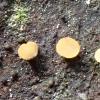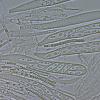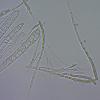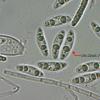
01-01-2026 18:35
Original loamy soil aside a artificial lake.The co

31-12-2025 19:27
Collected from loamy soil, at waterside (completel

30-12-2025 16:44
Pascal DucosBonjour,Une anamorphe rose stipitée, très nombre

30-12-2025 17:14
 Bernard CLESSE
Bernard CLESSE
Bonjour à toutes et tous,Pourriez-vous aider Albe

29-12-2025 10:15
Hulda Caroline HolteHello, I found and collected this propoloid ascom

30-12-2025 09:04
Hello.A Pyrenomycete sprouting sparsely but very d

29-12-2025 17:44
Isabelle CharissouBonjour,J'aimerais savoir si d'autres personnes au

Good evening everybody,
This afternoon we found some small yellow discs with dentate margin on leaves of Quercus.
The asci were cylindrical, thick walled, 120x14µ, 8-spored and IKI pos. Paraphyses were filiform and contained long refractive vacuoles. Spores measured 20-22x6-7µ and had 2 large guttules.The outer excipulum consisted of textura angularis.
I think it is something of the subfamily Dermateoideae.
Someone could help me further?


Zotto;
You are right I have been misleaded by the general key in Nordic Macromycetes where the slightly brown excipulum and the angular cells brought me to the Dermateaceae.
But all the typical features of P epiphyllum were present including the reddening after damaging
Thanks
Marc







